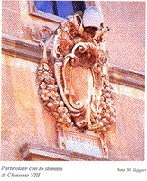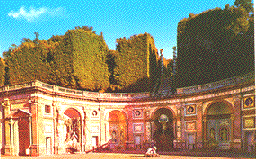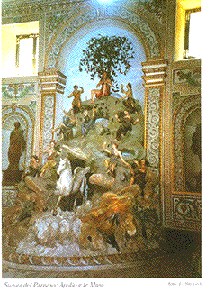Villa Aldobrandini
|
Villa Aldobrandini |
||
|
The original plan of the Villa dates back to the mid-16th century, when Monsignor Alessandro Rufini built a small building on the ruins of the Roman Villa of the Ottavi, and later on, the Attilii families, where he could spend his leisure time. In 1559, the Villa was acquired by the Vacca family and in 1560 by doctor Pier Antonio Contugi; Pier Antonio's son, Francesco Contugi, gave it in 1584 to Leonardo Tournassier who, in turn, sold it to Geronimo Boncompagni. The heirs of Boncompagni sold it back to Tournassier; in 1588, Monsignor Paolo Capranica was the owner of the Villa, which on his death, was handed down to the Apostolic Chamber. |
||
 |
|||||||||||||||
|
Finally, in 1598, Pope Clement VIII donated the Villa to his nephew, Cardinal Pietro Aldobrandini. In 1601, the Cardinal commissioned Giacomo della Porta to make changes, worthy of the new owner, to the small Villa. The great architect then designed the magnificent Palace that one can admire still today and which completely replaced the modest house of the Contugi family. On Giacomo della Porta's death, Carlo Maderno took over the remodelling works, while Giovanni Fontana followed the hydraulic works. In the meanwhile, Cavalier d'Arpino left his signature on five splendid frescoes, on the first floor. |
|||||||||||||||
 |
|||||||||||||||
|
The delightful Theatre of the Waters has to be attributed to Maderno and Fontana; the central statue of Atlante supporting the world is flanked by a Cyclops and a centaur, the one playing a mouth-organ and the other a trumpet, with a hydraulic device designed by Fontana. |
|||||||||||||||
 |
|||||||||||||||
|
On the left-hand side of the theatre is St. Sebastian's Chapel, decorated with frescoes by Domenico Passignano, whereas on the right-hand side is the famous Room of Parnaso, decorated by Domenichino, with the nine Muses and Apollo. In the loggia, on the second floor of the Palace, it is worth to mention the sculptures of the four Seasons, realized by Pietro Bernini, with contributions by his son, Gian Lorenzo. |
|||||||||||||||
|
|
|||||||||||||||